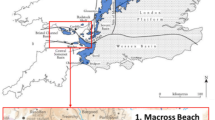Abstract
This present paper presents an adopted methodology for Micro Tunnel Boring Machine (TBM) selection, based on the results of a geological-geotechnical feasibility assessment of a microtunnel, planned for a natural gas pipeline beneath an active landslide, in the Corovode area, southern Albania. This example offers an excellent case study of diverse and demanding engineering geological formations, namely disturbed and sheared types of flysch rock masses, but also recent soil deposits. A tunnel drive will confront materials that may be prone to posing challenges, such as ravelling ground at the microtunnel face, chimney failures, water inflows, as well as deformations. The selection of the appropriate tunnelling method procedure is analysed and presented step by step, addressing all issues that cover the most critical aspects of the selection process. Finally, a geotechnical feasibility assessment is presented as an overall analysis of this work, taking into consideration all the crucial design parameters for several Micro TBM types along the tunnel. Besides the expected rock mass behaviour, the TBM selection is also based on the percentage of fines at the tunnel excavation profile, the permeability and hydraulic head, which is also investigated in this study, while sticky behaviour, clogging risk, presence of obstacles and mixed ground conditions are also taken into account.

















Similar content being viewed by others
References
AITES-ITA Working Group No. 14 (2000) Recommendations and Guidelines for Tunnel Boring Machines (TBMs), www.ita-aites.org
Barla G, Pelizza S (2000) TBM tunnelling in difficult ground conditions. Geo Eng 2000, Melbourne
Bergeson W (2014) Review of long drive microtunnelling technology for use on large scale projects. Tunn Undergr Space Technol 39(2014):66–72
Bieniawski Z.T, Tamames B.C, Fernandez J.M.G, Hernandez M.A (2006) Rock mass excavability (RME) indicator: new way to selecting the optimum tunnel construction method. In: ITA-AITES World Tunnel Congress & 32nd ITA General Assembly, Seoul, Korea
BTS-ICE (2005) Closed – face Tunnelling machines and ground stability, a guideline for best practice, British Tunnelling society in association with the Institution of Civil Engineers. Thomas Telford Publishing, London
Einstein H.H, Dudt J.P, Halabe V.B, Descoudres F (1992) Decision aids in tunnelling – principle and practical application, Monograph. Swiss Federation Office of Transportation
Farrokh E, Rostami J (2009) Effect of adverse geological condition on TBM operation in Ghomroud tunnel conveyance project. Tunn Undergr Space Technol 24:436–446
GeodataS.p.A. (1995) Report: Review of alternative construction methods and feasibility of proposed methods for constructing Attiko Metro Extension of Line 3 to Egaleo, Attiko Metro S.A., 191–193 Messoghion Ave., 11525 Athens, Greece
Gong Q, Yin L, Mab H, Zhao J (2016) TBM tunnelling under adverse geological conditions: an overview. Tunn Undergr Space Technol 57:4–17
Grandori R, Gager M, Antonini F, Vigle A (1995) Evinos-Mornos tunnel – Greece. In: Proceedings of the Rapid Excavation & Tunnelling Conference, pp. 747–767
Guetter W, Weber W (2001) Two tunnels in totally different geological formations driven by the same 7m double-shield TBM with an extremely thin-walled monoshell honeycomb segmental lining system. Rapid Excavation and Tunneling Conference
Hoek E, Marinos P (2000) Predicting tunnel squeezing. Tunnels and Tunnelling International Part 1: November, 45–51. Part 2: December, pp. 34–36
Kavvadas M, Litsas D, Fortsakis P, Prountzopoulos G, Tzivakos K, Chortis P (2013) Report on the State-of-Art with Collection of Data from TBM Tunnelling, NETTUN Research Objective, Measurement of Excavated Materials Volume in TBM tunnelling (WP-9), In: Controlling the impact of tunnelling on surrounding structures
Langmaack L (2002) Soil conditioning for TBM-Chances and limits, Journées d’études internationales de Toulouse, Underground works: Living structures, AFTES
Maidl B, Herrenknecht M, Maidl U, Wehrmeyer G (2012) Mechanised shield tunnelling, Ernst & Sohn
Marinos V (2012) Assessing rock mass behaviour for tunnelling. Environ Eng Geosci 18(4):327–341
Marinos V (2014) Tunnel behaviour and support associated with the weak rock masses of flysch. J Rock Mech Geotech Eng 6(3):227–239
Marinos V (2017) A revised, geotechnical classification GSI system for tectonically disturbed heterogeneous rock masses, such as flysch. Bull Eng Geol Environ. https://doi.org/10.1007/s10064-017-1151-z (online first)
Marinos P, Hoek E (2000) GSI: a geologically friendly tool for rock mass strength estimation, In: Proceedings of the GeoEng2000 at the international conference on geotechnical and geological engineering, Melbourne, Technomic publishers, Lancaster, pp. 1422–1446
Marinos V, Fortsakis P, Prountzopoulos G (2011) Estimation of geotechnical properties and classification of geotechnical behaviour in tunnelling for flysch rock masses, In: Anagnostopoulos, A. Pachakis, M. & Tsatsanifos, C. (eds), Geotechnics of Hard Soils – Weak Rocks, Proceedings of the 15th European Conference on Soil Mechanics and Geotechnical Engineering, Athens, Greece, 12–15 September, 1: 435–440. Amsterdam: IOS Press
Nord G, Stille H (1988) Bore and blast techniques in difficult types of rock: Sweden’s experience. Int J Tunnel Underground Space Technol 3(1):45–50
Pipe Jacking Association (1995) An introduction to pipe jacking and microtunnelling design. UK, London
Shahriar K, Sharifzadeh M, Hamidi JK (2008) Geotechnical risk assessment based approach for rock TBM selection in difficult ground conditions. Tunn Undergr Space Technol 23:318–325
Thewes M, Burger W (2004) Clogging risks for TBM drives in clay, Tunnels & Tunnelling International, June, pp. 28–31
Acknowledgements
We would like to acknowledge “E.ON Technologies GmbH (Currently Uniper GmbH)” S.A for funding the research programme “Assessment of Earthquake Loading & Seismic Response of TAP Project". Thanks are extended to Theodoros Stimaratzis for his contribution in the site investigation field work of this study.
Author information
Authors and Affiliations
Corresponding author
Rights and permissions
About this article
Cite this article
Marinos, V., Stoumpos, G., Papouli, D. et al. Selection of TBM and geotechnical assessment of a microtunnel in a difficult geological environment: a case of a natural gas pipeline beneath an active landslide (Albania). Bull Eng Geol Environ 78, 1795–1813 (2019). https://doi.org/10.1007/s10064-018-1241-6
Received:
Accepted:
Published:
Issue Date:
DOI: https://doi.org/10.1007/s10064-018-1241-6




